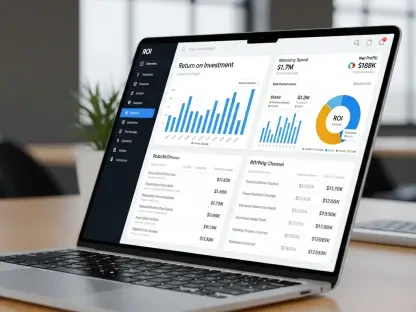Overview of the U.S. Holiday Retail Landscape
The holiday season stands as a cornerstone of the U.S. retail industry, driving nearly 19% of annual retail revenue and serving as a critical barometer for economic health, while consumer spending accounts for approximately 70% of the nation’s GDP. The November and December shopping frenzy offers a vital pulse check on financial trends. This period often dictates the success of retailers, from small businesses to corporate giants, while shaping broader economic forecasts for the year ahead.
Today, the retail landscape is a dynamic blend of traditional brick-and-mortar stores and rapidly expanding e-commerce platforms. Major players like Walmart, Target, and Amazon dominate the market, with online sales continuing to capture a growing share of consumer dollars. The shift toward digital shopping has reshaped strategies, pushing retailers to invest in seamless online experiences while maintaining in-store appeal through holiday promotions and events.
The significance of this season extends beyond mere transactions, reflecting consumer confidence and spending power amid evolving economic conditions. As the industry braces for a landmark moment with a projected trillion-dollar milestone, understanding the interplay between online and offline channels, alongside consumer behavior, becomes essential for stakeholders aiming to capitalize on this pivotal time.
NRF’s Groundbreaking Holiday Spending Prediction
Key Forecast Figures and Growth Trends
The National Retail Federation (NRF) has projected holiday spending for November and December to reach an unprecedented $1.01 to $1.02 trillion, marking the first time this threshold has been crossed. This forecast signals a growth rate of 3.7% to 4.2% compared to last year’s figures, though it reflects a slowdown from the 4.3% increase recorded previously. The deceleration hints at shifting economic dynamics influencing consumer wallets during this critical period.
Comparative data from other industry analysts reinforces this trend of moderated growth. Mastercard SpendingPulse anticipates a 3.6% rise, while Deloitte projects a range of 2.9% to 3.4%. Adobe, focusing on digital transactions, estimates a slightly higher 5.3% growth for online sales. Collectively, these predictions underscore a cooling momentum in spending increases, prompting retailers to adapt to a more cautious market environment.
This tempered growth trajectory, while still positive, suggests that the explosive surges seen in earlier years following economic recovery periods are no longer the norm. Retailers now face the challenge of sustaining momentum in a landscape where consumer priorities and economic pressures are reshaping spending patterns, necessitating a sharper focus on value and efficiency.
Consumer Behavior Shifts and Market Drivers
Amid the trillion-dollar forecast, consumer behavior is undergoing notable transformation, with shoppers displaying heightened selectivity in their purchases. A clear preference for discounts and deals has emerged, as many prioritize essential items over discretionary splurges. This trend is evident in reduced spending on non-essential activities, such as family outings or dining, as households tighten budgets.
Economic uncertainty plays a significant role in this shift, creating a disconnect between declining consumer confidence and sustained spending levels. Despite eroded optimism about financial stability, spending resilience persists, driven largely by value-seeking habits. Shoppers are increasingly hunting for promotions, leveraging both online tools and in-store offers to maximize their budgets during the holiday rush.
The growth of online sales remains a pivotal driver, with Adobe’s forecast highlighting a robust 5.3% uptick in e-commerce. Digital platforms offer convenience and competitive pricing, drawing consumers away from traditional shopping experiences. This migration to online channels is reshaping how retailers allocate resources, pushing investments into technology and logistics to meet demand in a fiercely competitive virtual marketplace.
Economic and Political Challenges Impacting Retail
The holiday retail season is not without significant hurdles, chief among them being the longest U.S. government shutdown on record, spanning 37 days at the time of this forecast. This disruption has halted the release of crucial economic data, such as job reports and retail sales figures, creating uncertainty for businesses. The absence of reliable information complicates planning and forecasting for retailers navigating an already volatile market.
Income inequality further compounds these challenges, with stark disparities in spending growth across different economic brackets. According to Bank of America data, lower-income households recorded a mere 0.6% increase in spending for September, while higher-income groups saw a 2.6% rise. This gap, fueled by faster wage growth among wealthier demographics, strains the ability of less affluent consumers to keep pace with rising costs, impacting overall retail performance.
Additionally, escalating costs driven by tariffs, inflation, and operational shifts pose persistent threats. Bank of America estimates that U.S. consumers bear 50% to 70% of tariff expenses, directly contributing to price hikes. Retailers also grapple with job cuts stemming from corporate restructuring and investments in artificial intelligence, adding layers of complexity to maintaining profitability during the high-stakes holiday period.
Policy and External Pressures on the Retail Sector
Regulatory and policy landscapes are exerting considerable influence on retail dynamics, particularly through tariffs implemented under the current administration. These levies have fueled inflation, raising consumer prices and squeezing household budgets. Retailers, in turn, face the dual challenge of absorbing costs and passing them on without alienating price-sensitive customers, a balancing act that shapes holiday strategies.
The ongoing government shutdown exacerbates these pressures by creating data blackouts, as noted by NRF CEO Matthew Shay. Without access to timely economic indicators, retailers and analysts struggle to make informed decisions, heightening the risk of missteps in inventory and pricing. This uncertainty ripples through supply chains, affecting how businesses prepare for peak shopping demand.
Such external factors necessitate adaptive responses from the retail sector, with many turning to aggressive promotional tactics and flexible pricing models. The ability to pivot in response to policy-driven cost increases and data gaps will likely determine which companies thrive amid these constraints. As political and economic tensions persist, the industry must brace for continued volatility while seeking innovative ways to connect with consumers.
Future Outlook for Holiday Retail and Beyond
Looking ahead, the retail industry faces a landscape marked by slower spending growth and enduring economic challenges. The trillion-dollar holiday milestone, while historic, comes against a backdrop of cautious consumer behavior and persistent headwinds like inflation. Retailers must anticipate further moderation in growth rates, adjusting expectations and strategies to align with a more restrained spending environment.
Emerging disruptors, such as evolving consumer preferences for value and advancements in e-commerce technology, will shape the sector’s trajectory. Digital innovation offers opportunities to enhance shopping experiences through personalized promotions and streamlined checkout processes. However, policy uncertainties, including potential tariff expansions, alongside global economic fluctuations, could temper domestic retail gains if not addressed through proactive measures.
Growth potential lies in bridging income disparities and leveraging targeted marketing to reach diverse consumer segments. Retailers can capitalize on digital tools to offer tailored deals that resonate with budget-conscious shoppers. As the industry navigates these complexities, adaptability and a focus on customer-centric solutions will be key to sustaining momentum in holiday seasons and beyond, ensuring resilience in an unpredictable economic climate.
Conclusion: Balancing Optimism with Caution
Reflecting on the historic trillion-dollar holiday forecast, the U.S. retail industry celebrates a remarkable achievement that underscores the enduring power of consumer spending. Yet, this milestone is tempered by challenges, including slower growth rates, economic disparities, and external pressures like government shutdowns and tariffs. These factors cast a shadow over the season’s success, revealing vulnerabilities that demand strategic attention.
Moving forward, retailers need to prioritize value-driven approaches, focusing on competitive pricing and digital innovation to capture cautious consumers. Strengthening adaptability through flexible operational models emerges as a critical step to weather policy uncertainties and economic fluctuations. By focusing on these actionable strategies, the industry can position itself to not only navigate immediate hurdles but also build a foundation for sustained growth in future holiday seasons.









